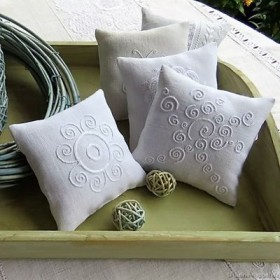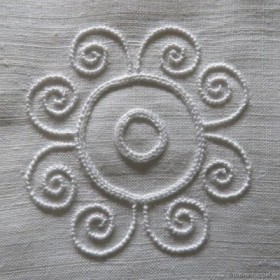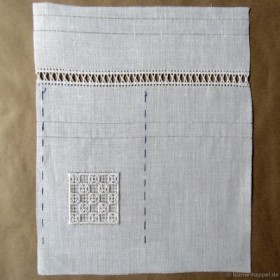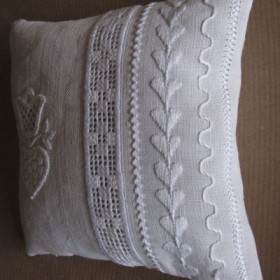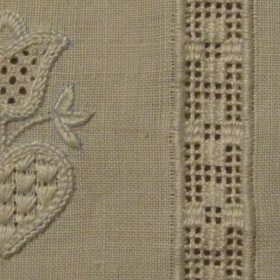Today, I present some very special practice exercises. Looking for designs that would be suitable for practicing stitching tendrils, I got the idea to ask an artist. I was really surprised and delighted to receive designs from Gudrun Hartwig! She also designed the fabulous Fairy Tale creations on my blog. I asked her for square designs measuring 10 cm X 10 cm. As requested, one can work the designs with or without the square outline.
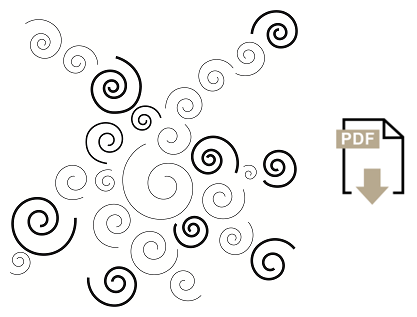
To make another pincushion, I stitched a design without the square outline. First, I used two different thread weights – No. 16 and No. 20. A third – thicker – thread would be good for working tendrils with differing thicknesses. So I also used a No. 12 thread.
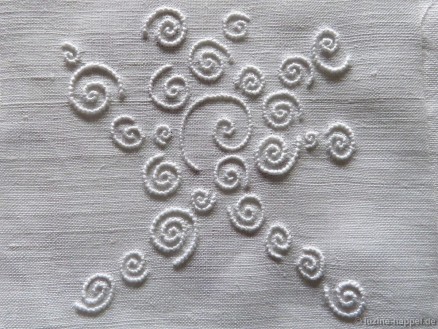 My finished project is very special, isn’t it?
My finished project is very special, isn’t it?
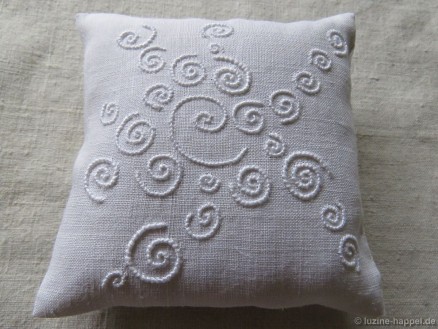 Here are some more stunning designs; they will allow you to make unique projects while practicing stitching tendrils.
Here are some more stunning designs; they will allow you to make unique projects while practicing stitching tendrils.
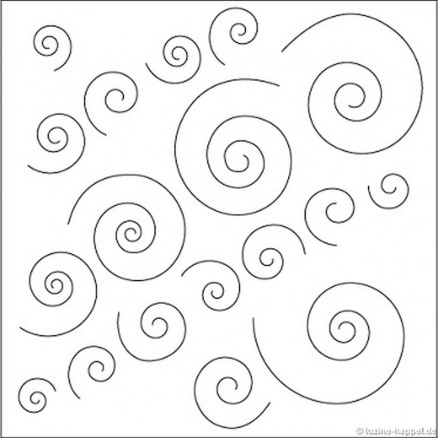
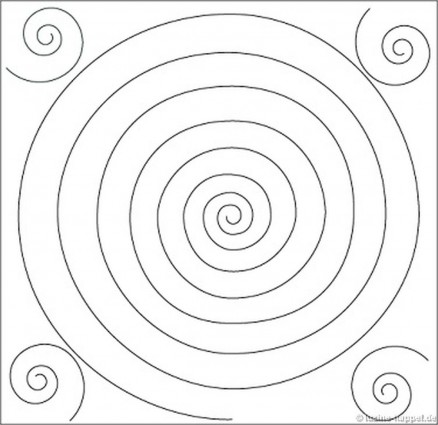
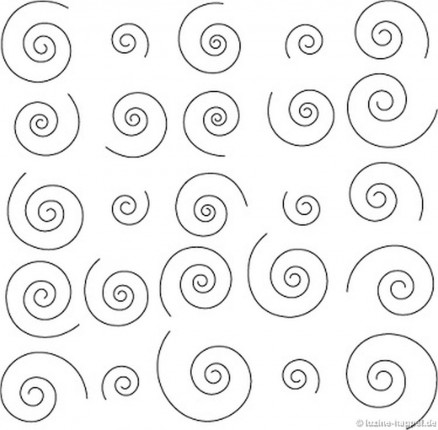
“Practice make perfect” when it comes to stitching tendrils. Presented here are two similar designs to make two different projects – perfect for learning to stitch tendrils.
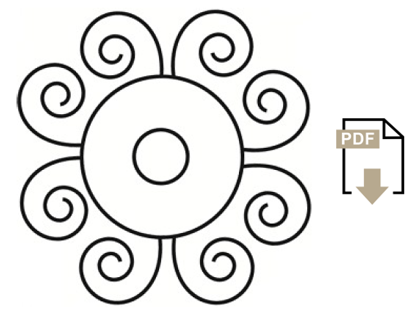
The first design measures 7.5 cm X 7.5 cm. The design is transferred to a piece of linen measuring 14 cm X 26 cm. A pincushion will be worked. The first steps can be found here, and the finishing steps can be found here. (One can also work such a pincushion using two pieces of fabric each measuring 14 cm X 14 cm.)
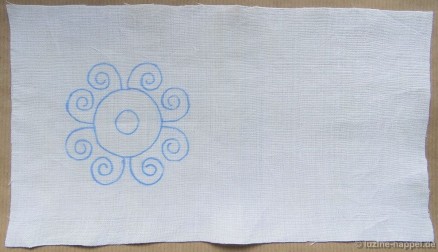 For my example, I used a fine handwoven linen and coton à broder No. 16 for all the Coral knot stitches.
For my example, I used a fine handwoven linen and coton à broder No. 16 for all the Coral knot stitches.
(You will notice that a circle design on a piece of fabric stretched in a hoop will be no longer be a true circle. This doesn`t matter because it will return to a circle in the end.)
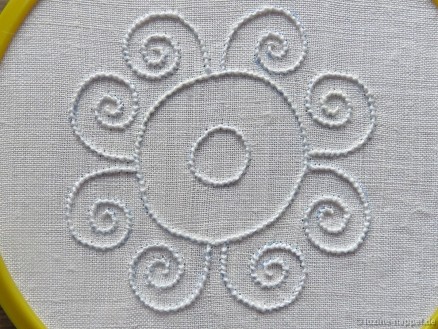 Since the focus is to practice stitching tendrils, a filling pattern for the shape in the center or for the ring is not absolutely necessary. However, the ring with only Coral Knot lines is not prominent enough. So, using coton à broder No. 20, Chain stitches are worked next to the Coral Knot lines.
Since the focus is to practice stitching tendrils, a filling pattern for the shape in the center or for the ring is not absolutely necessary. However, the ring with only Coral Knot lines is not prominent enough. So, using coton à broder No. 20, Chain stitches are worked next to the Coral Knot lines.
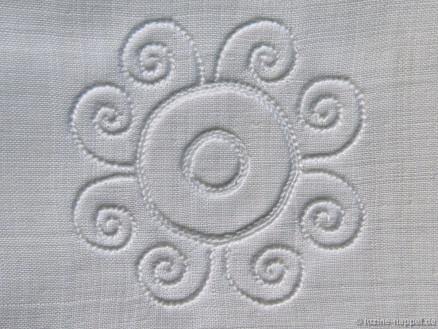 The piece is washed – please wash gently so that the fabric edges will not fray – starched, and ironed.
The piece is washed – please wash gently so that the fabric edges will not fray – starched, and ironed.
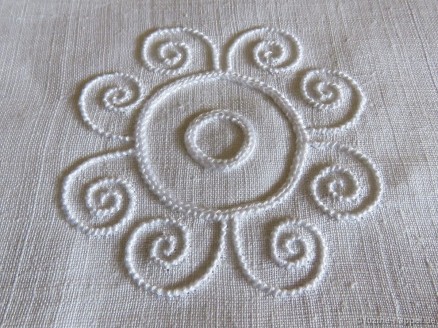 Then, the piece is sewn, filled, and secured.
Then, the piece is sewn, filled, and secured.
A nice little pincushion is finished.
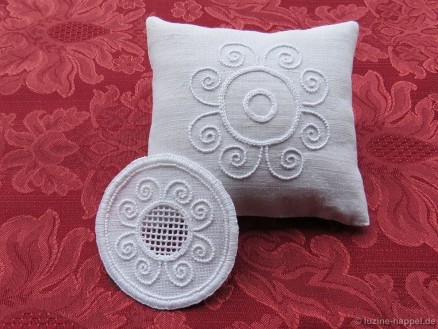 For the second project – an ornament – the design is shrunk so that it fits into a ring with a diameter of about 7.5 cm. The inner circle is deleted so that the center can accommodate a filling pattern.
For the second project – an ornament – the design is shrunk so that it fits into a ring with a diameter of about 7.5 cm. The inner circle is deleted so that the center can accommodate a filling pattern.
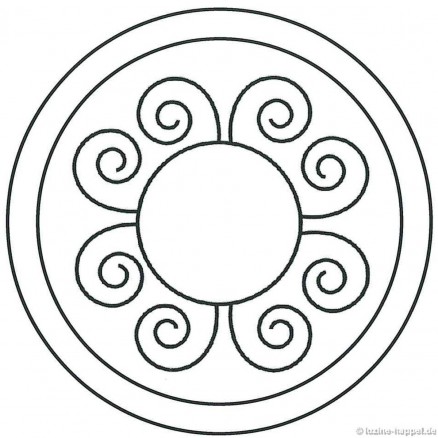 Coton à broder No. 16 is used for Coral Knot stitches, No. 20 for Blanket stitches and for Chain stitches. At the outside edge, Coral Knot stitches are worked along the inner line. Chain stitches are worked a small distance outside these Coral Knot stitches. The outside Chain stitches are covered with densely worked Blanket stitches between the outline and the Coral Knot line.
Coton à broder No. 16 is used for Coral Knot stitches, No. 20 for Blanket stitches and for Chain stitches. At the outside edge, Coral Knot stitches are worked along the inner line. Chain stitches are worked a small distance outside these Coral Knot stitches. The outside Chain stitches are covered with densely worked Blanket stitches between the outline and the Coral Knot line.
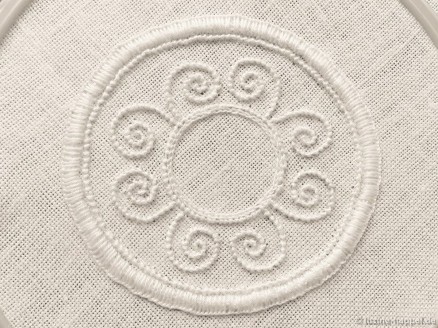 Using coton à broder No. 16 all remaining Coral Knot stitches are worked, and using coton à broder
Using coton à broder No. 16 all remaining Coral Knot stitches are worked, and using coton à broder
No. 30 Chain stitches are worked directly inside the Coral Knot stitches of the center circle. The shape is filled with an openwork Cable stitch grid. For detailed descriptions please refer to my books Basic Principles of Schwalm Whitework, Openwork Pattern Samplers or Ornaments (lesson #3). Openwork is nice for an ornament and pleasantly contrasts with the outside ring with the tendrils.
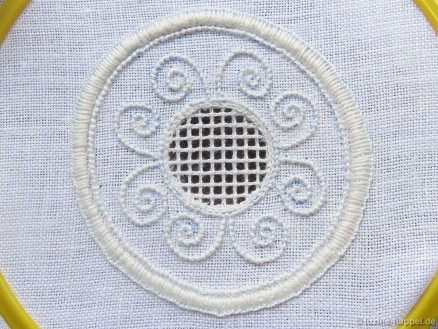 After finishing, the embroidered piece is washed (boiled), starched, and ironed.
After finishing, the embroidered piece is washed (boiled), starched, and ironed.
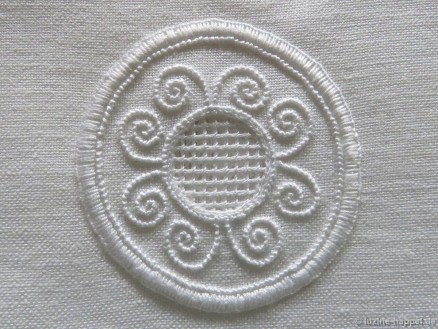 Then, the circle is cut.
Then, the circle is cut.
The result is one more nice ornament for trimming the tree.
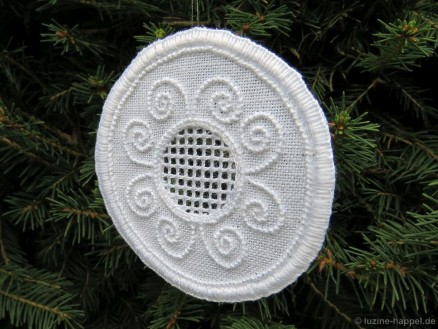 This design is also nice for decorating a long, small pattern band with a couple of similar patterns.
This design is also nice for decorating a long, small pattern band with a couple of similar patterns.
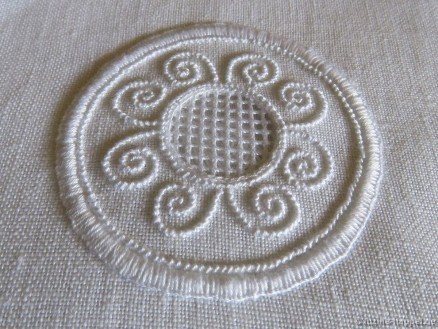 I hope you enjoy these practice exercises!
I hope you enjoy these practice exercises!
Begin with a piece of 13.5/cm thread-count linen cut to measure 20 cm X 25 cm.
6 cm down from the top edge (an edge that measures 20 cm wide), withdraw threads for the folded Peahole edging.
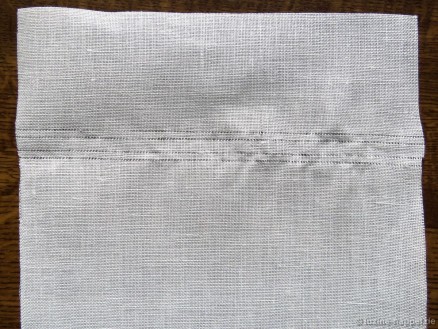 A Peahole hem is worked starting directly over from one side – it makes no difference if it is the right or left. Therefore, two rows of Four-Sided stitches are worked. Please note that these rows must contain an even number of Four-Sided stitches. Any excess fabric is cut along the entire side after finishing both rows of Four-Sided stitches.
A Peahole hem is worked starting directly over from one side – it makes no difference if it is the right or left. Therefore, two rows of Four-Sided stitches are worked. Please note that these rows must contain an even number of Four-Sided stitches. Any excess fabric is cut along the entire side after finishing both rows of Four-Sided stitches.
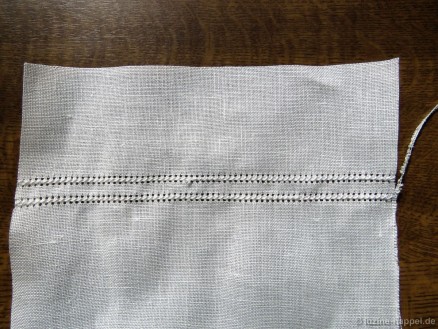 The Peaholes can be worked later.
The Peaholes can be worked later.
Using a contrasting thread color and Running stitches, mark the seam allowance (8 fabric threads from the side edge) along one side, the longitudinal axis, and also the middle between the two just marked lines.
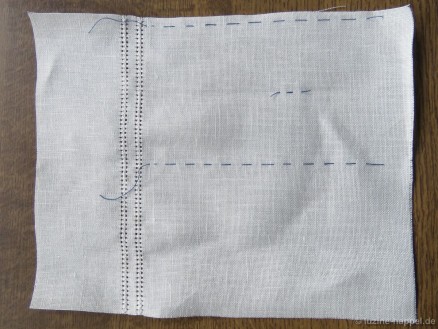 A Limet-Filling pattern in a square shape should be worked. And the pattern should fit fully into the square. So it is necessary to withdraw fabric threads step by step, exactly counting out the correct size.
A Limet-Filling pattern in a square shape should be worked. And the pattern should fit fully into the square. So it is necessary to withdraw fabric threads step by step, exactly counting out the correct size.
Withdrawal of threads is done from the back.
About 5 cm up from the bottom edge, in the middle between the two marked lines, a vertical fabric thread is cut and withdrawn toward the top – step by step – about 3.5 cm.
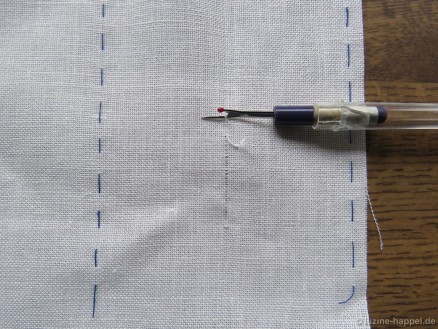 (Please keep in mind, the above picture shows the back side of the bag. By placing the Limit-Filling pattern to the right of the center mark on the back side, the cording – when all is finished – will emerge on the left side of the bag. If you want the cording to be on the right side of the bag, you need to place the pattern on the left side of the longitudinal axis.)
(Please keep in mind, the above picture shows the back side of the bag. By placing the Limit-Filling pattern to the right of the center mark on the back side, the cording – when all is finished – will emerge on the left side of the bag. If you want the cording to be on the right side of the bag, you need to place the pattern on the left side of the longitudinal axis.)
At the bottom end of the vertical withdrawn-thread line, a horizontal thread is cut and withdrawn to both sides about 1.5 cm each.
Now, away from the vertical withdrawn-thread line, more threads – 7 on the left and 7 on the right – are withdrawn leaving 3, cutting 1. They are cut at the horizontal withdrawn-thread line and withdrawn about 1–2 cm. Fifteen vertical withdrawn-thread lines are needed. If needed, carefully lengthen the horizontal withdrawn-thread line to accommodate all the needed vertical withdrawnthread lines.
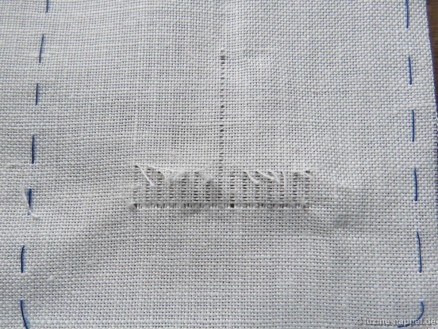 Both outermost cut threads are withdrawn 3.5 cm.
Both outermost cut threads are withdrawn 3.5 cm.
Between these, more horizontal threads are withdrawn by leaving 3 and cutting 1 – fifteen in all. If needed, carefully lengthen the vertical withdrawn-thread lines to accommodate all the needed horizontal withdrawn-thread line.
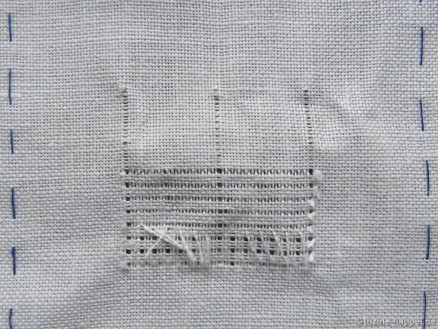 Now the remaining vertical threads are withdrawn step by step up to the upper line and cut.
Now the remaining vertical threads are withdrawn step by step up to the upper line and cut.
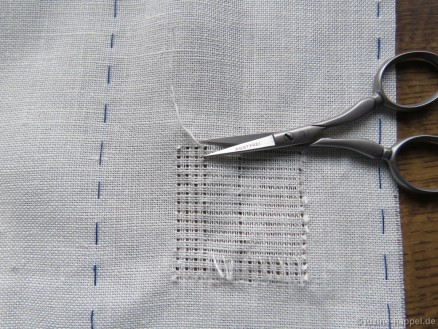 So a Limet grid, correctly sized for a special pattern, is created in the middle of the bag.
So a Limet grid, correctly sized for a special pattern, is created in the middle of the bag.
To secure the cut threads, Satin stitches should be worked outlining the Limet grid. To facilitate this, one more thread is cut in the middle of each side of the square, leaving 3 threads between. Both ends are withdrawn to their respective intersection points. The thread ends remain; they will be covered by the Satin stitches later.
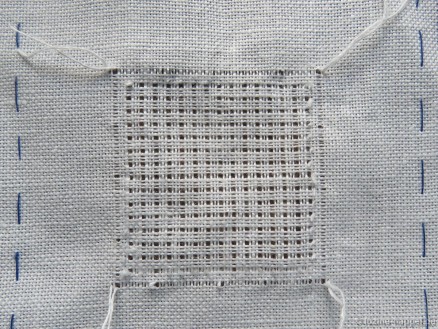 Now, from the right side of the fabric, using coton à broder No. 20, and working counterclockwise, one row of Satin stitches is embroidered between both outside thread lines.
Now, from the right side of the fabric, using coton à broder No. 20, and working counterclockwise, one row of Satin stitches is embroidered between both outside thread lines.
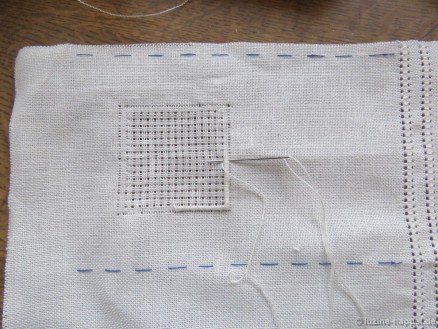 Then filling pattern 480 is worked into the Limet grid and the Peahole is worked.
Then filling pattern 480 is worked into the Limet grid and the Peahole is worked.
One horizontal thread is withdrawn 1 cm from the top edge to mark the seam allowance. A second thread is withdrawn 1.5 cm down from there to mark the casing seam for the cord. This withdrawnthread line has a distance of 3.5 cm to the Peahole hem.
Down from the bottom edge of the Peahole hem one more horizontal thread is withdrawn at a distance of 3.5 cm, a fourth thread is withdrawn 1.5 cm below.
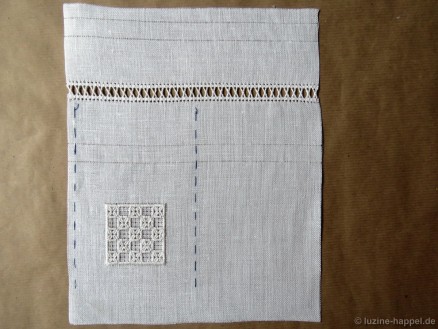 Now fold the piece along the longitudinal axis, right sides together. Sew together both layers along the marked line with Back stitches. This can be done hand or machine. For accuracy, it is more easy to do this step by hand. Start directly at the second withdrawn thread line and work up to the Four-Sided stitch of the Peahole hem. Secure working thread there.
Now fold the piece along the longitudinal axis, right sides together. Sew together both layers along the marked line with Back stitches. This can be done hand or machine. For accuracy, it is more easy to do this step by hand. Start directly at the second withdrawn thread line and work up to the Four-Sided stitch of the Peahole hem. Secure working thread there.
Start again at the opposite Four-Sided stitch of the Peahole hem and work up to the third withdrawn-thread line. Secure working thread there.
Start again at the fourth withdrawn-thread line and work along the remaining section the side and then along the bottom.
The keep the seam secure, work the first and the last stitch of each section several times.
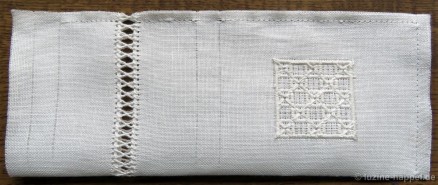 Trim seam allowance at the corner.
Trim seam allowance at the corner.
Open up side and bottom seam allowances and smooth them with the thumbnail.
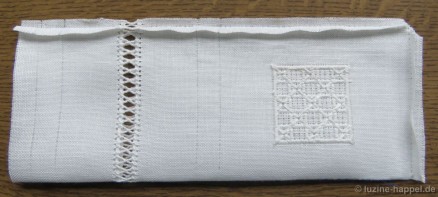 Fold down the seam allowance of the top edge and smooth it along the first withdrawn-thread line.
Fold down the seam allowance of the top edge and smooth it along the first withdrawn-thread line.
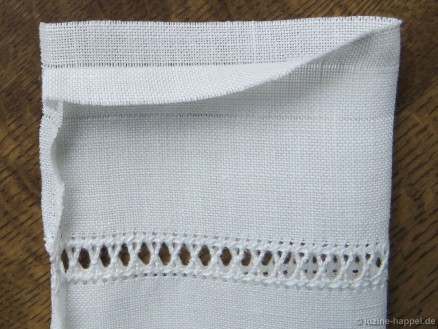 Fold it down again and lay the hem so that the first folded edge lies directly above the last withdrawn-thread line.
Fold it down again and lay the hem so that the first folded edge lies directly above the last withdrawn-thread line.
Baste in place with short Running stitches. You will notice, that the under layer lies slightly curved and needs to be pressed a little bit to match the upper layer.
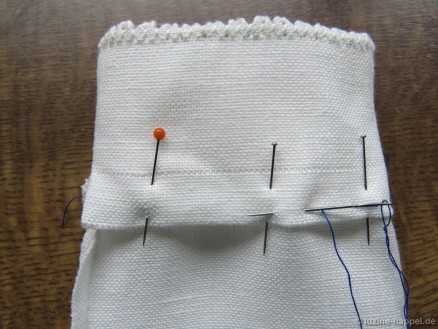 Secure the hem along the withdrawn-thread line with Antique hem stitches. So that the Antique hem stitches create a line of Back stitches on the right side of the bag, make sure that the vertical parts of the hem stitch catch only the two upper layers.
Secure the hem along the withdrawn-thread line with Antique hem stitches. So that the Antique hem stitches create a line of Back stitches on the right side of the bag, make sure that the vertical parts of the hem stitch catch only the two upper layers.
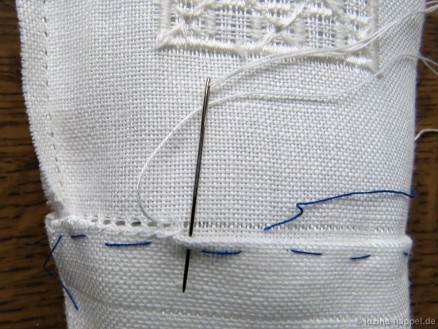 Turn inside out and work one row of Back stitches along the remaining withdrawn-thread line, catching both layers. Make sure to also meet the inside withdrawn-thread line by looking inside when the needle is on the inside of the bag.
Turn inside out and work one row of Back stitches along the remaining withdrawn-thread line, catching both layers. Make sure to also meet the inside withdrawn-thread line by looking inside when the needle is on the inside of the bag.
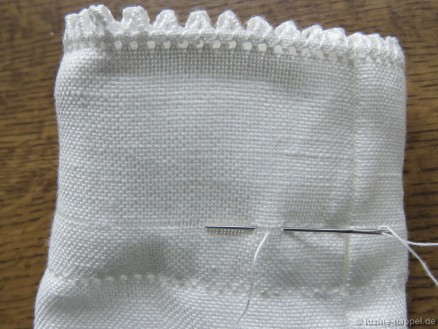 Secure the triangles of the folded Peaholes. In the area of the side seam, make sure to catch both layers of triangles so that they end up looking like one.
Secure the triangles of the folded Peaholes. In the area of the side seam, make sure to catch both layers of triangles so that they end up looking like one.
Insert a cord into the casing.
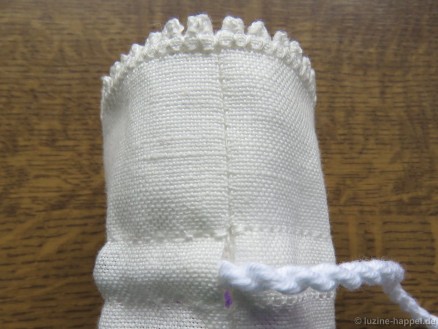 Decorate the bottom edge with needlelace scallops.
Decorate the bottom edge with needlelace scallops.
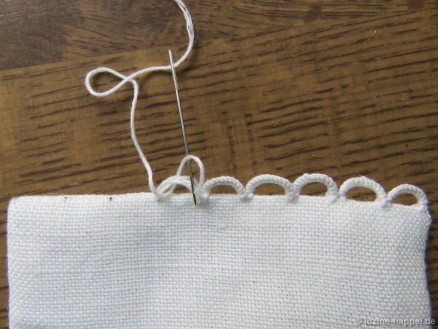 Wash and iron the finished piece, put an appropriately sized lavender pillow into the bag and close it.
Wash and iron the finished piece, put an appropriately sized lavender pillow into the bag and close it.
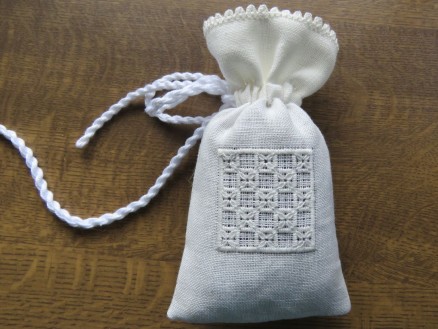 A cute whitework embroidery is finished and ready to be admired.
A cute whitework embroidery is finished and ready to be admired.
The small Schwalm borders and ornamental stitches should complement the other decorations on the pincushion.
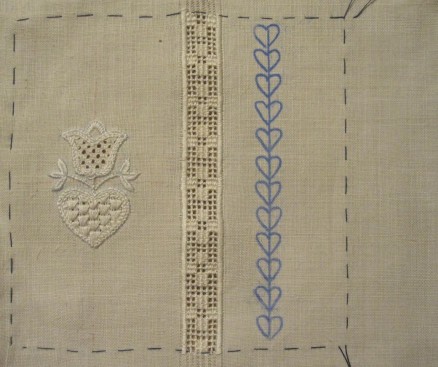 So, first a small heart border design is transferred on the straight of grain and stitched with Coral Knot stitches and Satin stitches.
So, first a small heart border design is transferred on the straight of grain and stitched with Coral Knot stitches and Satin stitches.
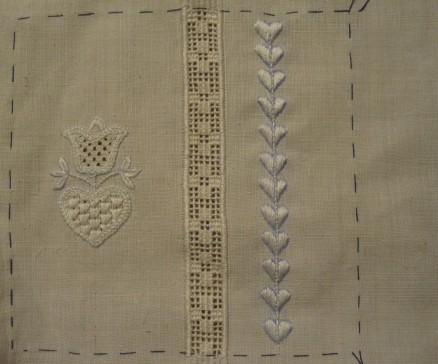 Additional decorations include “Schlängchen” (interlaced Herringbone stitches), “Kerrercher” (interlaced Running stitches) and a variation of Herringbone stitches.
Additional decorations include “Schlängchen” (interlaced Herringbone stitches), “Kerrercher” (interlaced Running stitches) and a variation of Herringbone stitches.
Many examples of small borders and typical ornamental stitches can be found in my download document “Schwalm Curved Lines, Narrow Borders, and Ornamental Stitches”, or you can design your own to complement the embellishments of the first two sections.
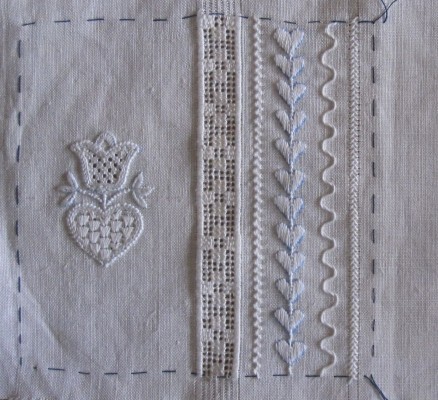 After finishing the embroidery, the fabric is cut to the measurement of 14 cm X 26 cm that was established at the beginning.
After finishing the embroidery, the fabric is cut to the measurement of 14 cm X 26 cm that was established at the beginning.
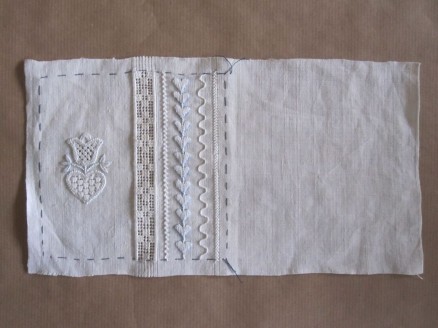 The piece is washed – please wash gently so that the fabric edges will not fray – starched and ironed.
The piece is washed – please wash gently so that the fabric edges will not fray – starched and ironed.
Then the piece is folded right sides together and sewn – just inside the blue marked lines – on two and a half sides (one must create an opening to turn inside out and for stuffing).
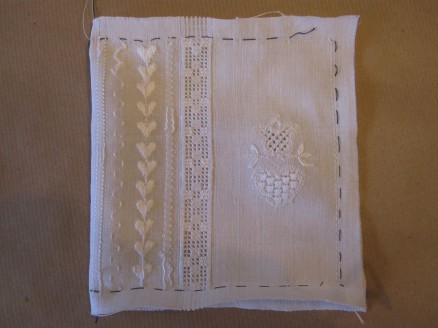 The marking thread is removed. Inside is turned out and the piece is ironed once more. The pincushion is filled with Poly-Fil, wool fleece, or wadding. The remaining seam allowance is folded inside and secured.
The marking thread is removed. Inside is turned out and the piece is ironed once more. The pincushion is filled with Poly-Fil, wool fleece, or wadding. The remaining seam allowance is folded inside and secured.
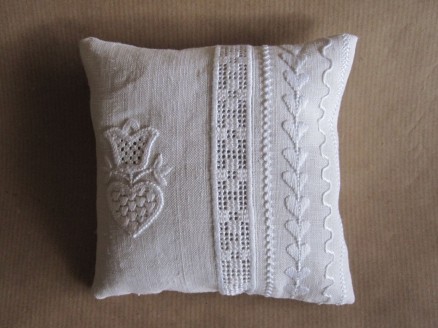 A nice little pincushion is worked.
A nice little pincushion is worked.
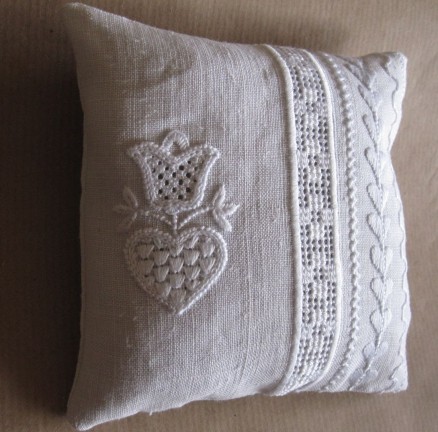 Were you able to envision this result in the beginning?
Were you able to envision this result in the beginning?
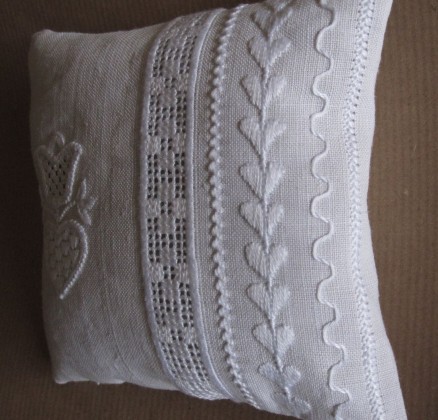
Personal critique: My first attempt did not turn out just as I had hoped. In particular, to accommodate the bowing of the pillow when it is stuffed, the motif at the left should not have been centered. The Openwork pattern band should have been started closer to the motif. Also, the motif could have been a little larger. And, I think, a little needlelace edging would make it a very special pincushion.
I hope you see that we all learn from trial and error and that we will accomplish very little if we expect perfection every time we pick up a needle and thread. Please, do not be afraid to make
mistakes!
Where you able to realize your ideas?
For the next section’s embellishment, I decided that an Openwork pattern band should be worked.
Therefore, one vertical thread is withdrawn. The motif just worked should be centered in its section, so the distance to the withdrawn thread line should equal the distance from the motif to the marked line on the left.
Please note: After finishing my pincushion, I realized that the motif should not be centered in its section. If it is centered, when the pincushion is stuffed the motif will look as though it is sliding off the left side of the pincushion. Either it is best to withdraw the first linen thread of the Openwork pattern band somewhat closer to the motif – it is a question of taste how close. Or, if the excess linen on the left allows, one can move the whole blue marked square 1 cm to the left to work a small border or an ornamental stitch on the left of the motif – similar to the original inspirational pincushion.
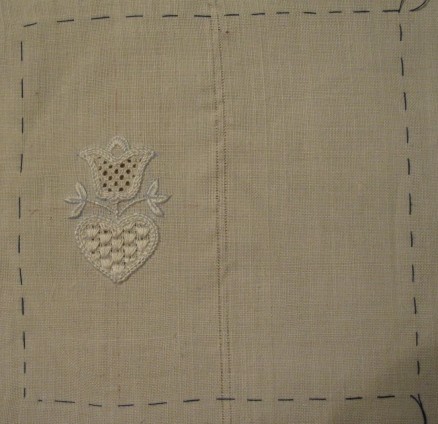
Over from this withdrawn thread line 4 threads are left and the next is withdrawn. One row of Satin stitches is worked over the 4 linen threads.
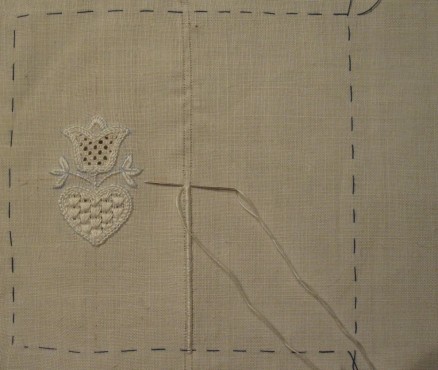
Next to the withdrawn thread on the right, another thread is withdrawn.
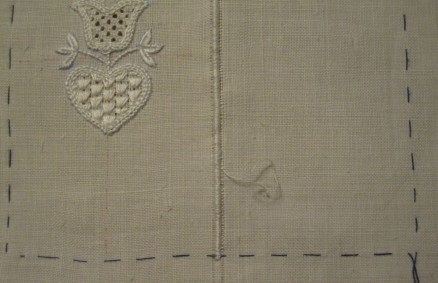
My Openwork pattern band is 6 squares wide. So, always alternating, 2 threads are left and 2 threads are withdrawn – 5 times in all. Then 4 threads remain and 1 more is withdrawn.
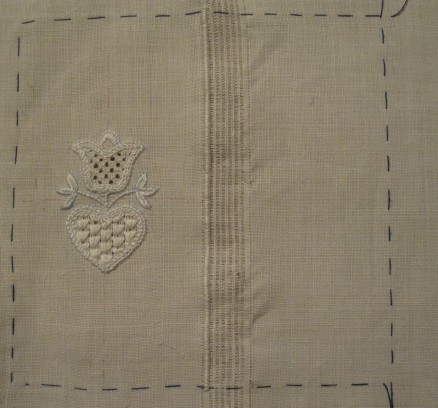
Over the 4 linen threads on the right, one row of Satin stitches is worked.
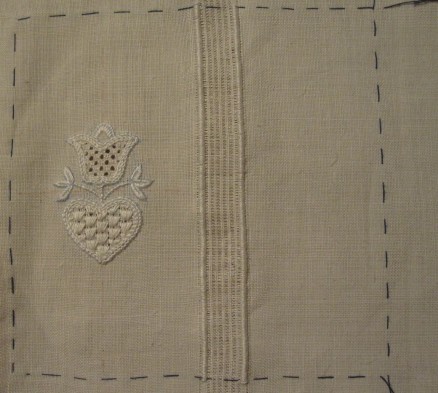
Then, to establish the Openwork grid (notice the section outlined in blue), the horizontal threads are withdrawn.
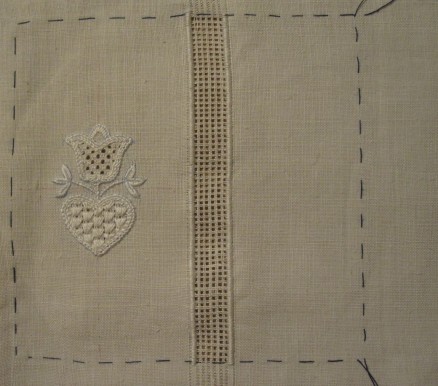
Next, the Openwork grid is secured with Cable stitch.
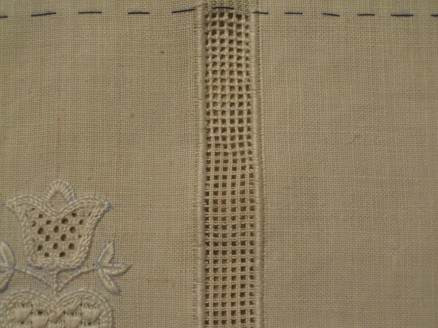
Into the established grid a Needleweaving pattern is worked. Suggestions for arranging such pattern bands can be found in Saumbaukasten or in Easter Eggs.
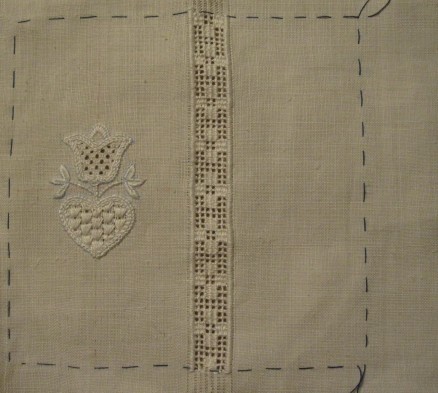
The second section is finished. The third section will be embroidered with small Schwalm borders and ornamental stitches. Can you envision how it will look?
